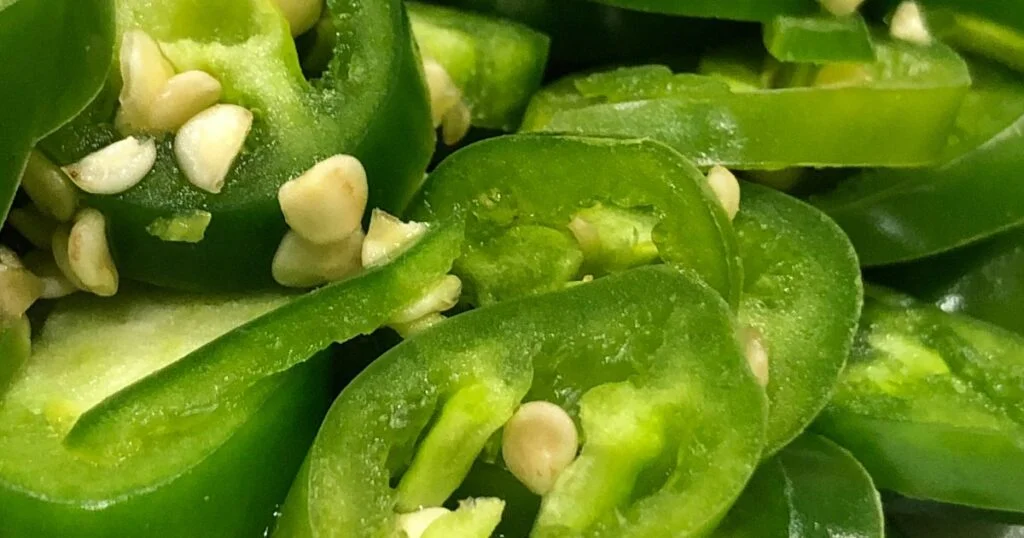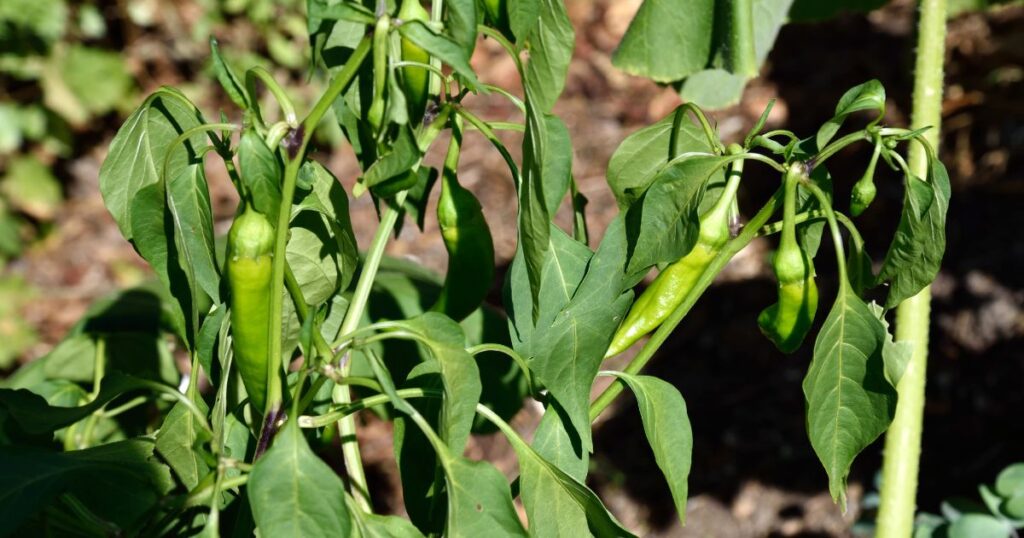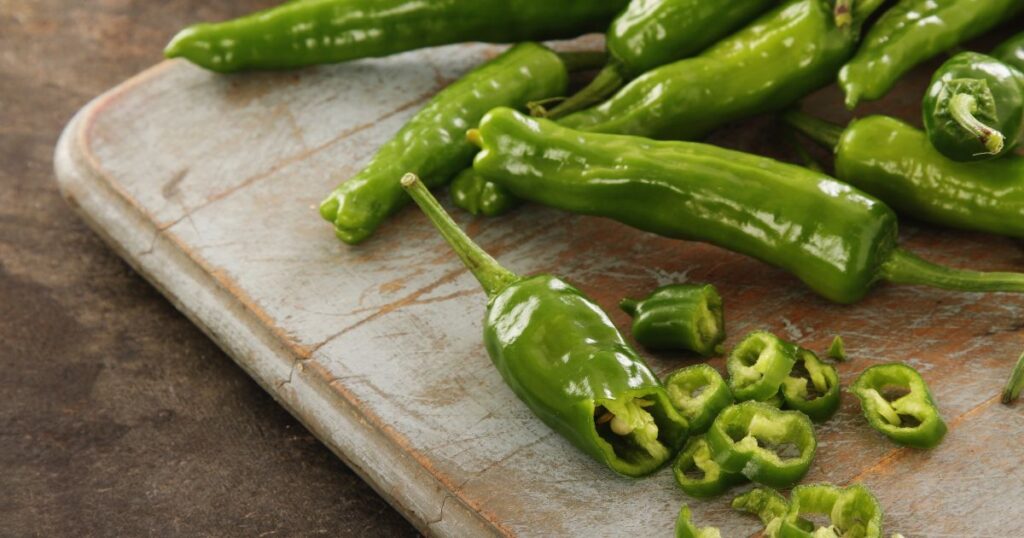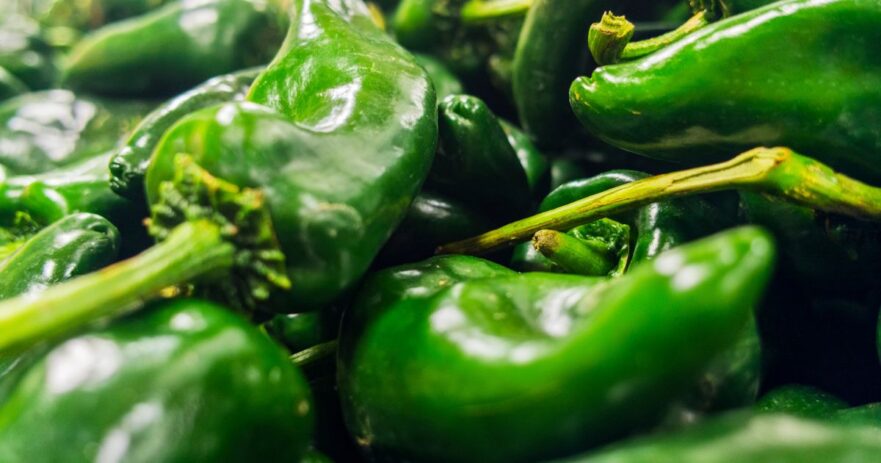In this article about Sport pepper:
🗺️ Origin and history | 🌶️ Uses | ✨ Appearance and taste | 🧑🌾 Growing – gardening | 👨🍳 Cooking – recipes | 🛒 Where to buy | 🫙 How to store | 👨⚕️ Health benefits | 🌶️ Alternatives and substitutes | ❓ Frequently asked questions
What is a sport pepper?
Sport peppers are small and moderately spicy chili peppers that originated in Mexico. You typically harvest when the peppers are still green and about 1.5 to 2 inches long. These peppers boast a medium heat level, ranging from 10,000 to 23,000 Scoville heat units.
Sport pepper is popularly used as a condiment for various dishes, particularly in the Chicago-style hot dog, where it’s pickled and added to the toppings. Their tangy, slightly spicy flavor complements and enhances the flavors of meats, sandwiches, and other savory dishes. Their crunchy texture and bright color also add a level of visual appeal to the culinary creations they’re a part of.
| Sport pepper | |
| SHU | 10,000 - 23,000 |
| Median SHU | 16,500 |
| Flavor | Tangy and slightly sweet, with a moderate heat |
| Species | Capsicum annuum |
| Origin | Mexico |
| Uses | Chicago-style hot dogs, sandwiches, pizzas, etc. |
Are Sport peppers spicy? How hot are they?
Banana pepper scoville: 10,000 to 23,000 SHU
Sport peppers are moderately spicy, with a Scoville rating of 10,000 to 23,000 units. To put this into perspective, jalapeño peppers rate between 2,500 and 8,000 Scoville units, making sport peppers the spicier of the two. However, they‘re less spicy than cayenne peppers, which can reach up to 50,000 Scoville units.
While sport peppers aren‘t as fiery as many other chili varieties, they still give a noticeable kick of heat that can elevate the flavor profile of various dishes. So if you enjoy a bit of spice without it being overwhelming, sport peppers can be an excellent choice to incorporate into your culinary adventures.
🗺️ ORIGIN AND HISTORYWhere do Sport peppers come from?
Sport peppers are believed to have originated in Mexico, though they’re popular in many places now. In the U.S., sport peppers have become particularly associated with Chicago-style cuisine, most notably as a key ingredient in the iconic Chicago-style hot dog. Chicago’s vibrant history and cultural diversity have contributed to the popularity and widespread use of sport peppers in various traditional and contemporary dishes.
🌶️ USES
What are sport peppers good for? How to use them?
Sport peppers are incredibly versatile and can be used in various dishes to add a spicy kick.
They are often enjoyed as a pickled condiment, preserved in a vinegar-based brine to maintain their flavor and spiciness. This process, also known as sport pepper canning, ensures these zesty treats are available year-round. Whether enjoyed on their own or incorporated into various dishes, pickled or canned sport peppers add a delightfully spicy kick to your favorite meals.
Combining sports peppers with celery salt is a classic combination that can elevate the flavor of various dishes. The blend of spicy, tangy sport peppers and savory celery salt creates a unique and flavorful seasoning that works well on sandwiches, salads, and grilled meats.
One of the most iconic uses for sport peppers is in a Chicago-style hot dog or hamburger. Topped with a generous amount of pickled sport peppers, these grab-and-go meals offer a perfect balance of spicy, tangy, and savory flavors that will delight your taste buds.
✨ APPEARANCE AND TASTEWhat does a Sport pepper look like?
Sport peppers are small and slender chili peppers, measuring about 1 to 1.5 inches long and less than half an inch in diameter. They‘re generally harvested when still green, but they can also be found in shades of red or yellow when fully ripe. The skin of sport peppers has a glossy finish. When pickled, they often gain a slightly wrinkled texture and become pale green.
What do Sport peppers taste like?
Sport peppers are known for their moderately spicy and tangy flavor profile. The heat level is generally higher than that of a pepperoncini, but not as intense as some other chili peppers like habaneros or tabasco pepper. This balanced spiciness makes sport peppers popular for adding a little kick to various dishes without overpowering the overall flavor. In addition to their heat, sport peppers also offer a tangy and slightly bitter taste, which is further enhanced when they are pickled. This combination of spicy and tangy notes makes sport peppers a versatile and flavorful addition to a wide range of culinary creations.
🧑🌾 GROWING – GARDENING
How to grow Sport peppers?
They thrive in warm climates with plenty of sunlight, making them suitable for growing in various environments. Plant them in well-draining soil to ensure healthy growth and provide consistent watering. It’s also essential to fertilize your sport peppers regularly, particularly during the growing season. That‘ll help to promote vigorous growth and a bountiful harvest.
When to pick Sport pepper?
Sport peppers can be grown in the ground or pots, and they usually require around 70-90 days from planting to harvesting. Keep an eye on their color, as you typically want to pick them when they‘re green, although they can also be harvested when they turn red or yellow for a slightly different flavor profile.
👨🍳 COOKING – RECIPES
Cooking / Recipe ideas for Sport peppers
Sport peppers can be used in various dishes to add a touch of heat and flavor, making them versatile ingredients for many recipes. One popular way to use sport peppers is in a sport pepper sauce. This sauce is perfect for drizzling tacos, eggs, or roasted vegetables. To make this sauce, blend together sport peppers, garlic, onion, vinegar, and a hint of honey or sugar for sweetness. The result is a spicy and flavorful sauce that‘ll elevate any dish.
Sport pepper canning is another excellent way to preserve and enjoy these peppers. To create your own pickled sport peppers, pack whole, clean peppers into a jar along with garlic and your choice of herbs. Next, cover the peppers with a mixture of vinegar, boiling water, salt, and sugar. Let the peppers sit for several days, letting the flavors meld together, and then enjoy your homemade pickled sport peppers.
Sport peppers are also a fantastic topping for hot dogs and hamburgers, adding a spicy kick to these classic favorites. The famous Chicago-style hot dog, for example, traditionally includes sport peppers, yellow mustard, chopped onions, relish, tomato wedges, a pickle spear, and a sprinkling of celery salt, all nestled within a poppy seed bun.
Similarly, you can add sport peppers to hamburgers, sandwiches, or even salads for an extra burst of heat and flavor. With their unique taste and heat level, sport peppers can enhance various dishes, making them a staple in many kitchens.
🛒 WHERE TO BUYWhere can I buy Sport peppers?
Sport peppers are usually available at grocery stores in the pickle or condiment aisle, typically sold as pickled sport peppers. However, depending on the store and region, they may also be found fresh in the produce section. If you’re having trouble locating them in your local grocery store, try checking out specialty food stores, ethnic markets, or farmers’ markets.
Many online retailers offer pickled sport peppers for those who prefer shopping online. These retailers can ship the peppers directly to your home, making it convenient to stock up on these flavorful and spicy peppers.
Where can I buy Sport pepper plants?
If you’re interested in growing your own sport pepper plants, you can find seedlings at garden centers, nurseries, or online retailers specializing in vegetable plants and seeds. When selecting sport pepper plants, look for healthy specimens with strong stems and bright green leaves.
Where can I buy Sport pepper seeds?
You can buy sport pepper seeds at most local gardening centers, nurseries, or through various online retailers specializing in seeds and gardening supplies. When buying seeds, make sure they‘re from a reputable source to guarantee quality and high germination rates. Once you have your sport pepper seeds, follow the planting instructions and provide them with the appropriate growing conditions to enjoy a bountiful harvest.
🫙 HOW TO STOREHow do I store Sport peppers?
To store fresh sport peppers, you can keep them in the refrigerator for up to two weeks before they start to deteriorate. Place the peppers in a plastic bag or airtight container, and store them in the crisper drawer of your fridge to maintain their freshness.
Pickled sport peppers can last in the refrigerator for a few months. Ensure that they‘re kept in their original jar or transferred to another airtight container, and then store them in the fridge to preserve their quality.
Can Sport peppers be frozen?
Sport peppers, especially in their pickled form, can absolutely be frozen to extend their shelf life. To freeze pickled sport peppers, first, drain them from the brine and pat them dry with a paper towel. Next, place the peppers in a single layer on a parchment-lined baking sheet and freeze for a few hours or until solid. Once the peppers are frozen, transfer them to airtight containers or heavy-duty freezer bags to prevent freezer burn. Label and date each, and store the frozen peppers for up to six months. Remember that freezing may alter the texture of the peppers, making them slightly softer when thawed, but the flavor will still be enjoyable.
❤️🩹 HEALTH BENEFITSAre Sport peppers healthy?
Pickled sport peppers can be a flavorful addition to your diet, offering some health benefits despite the changes that occur during the pickling process. Their vitamin A and C content is a bit reduced compared to fresh sport peppers, and their fiber content may vary.
Sport peppers contain capsaicin, the compound responsible for their spiciness, which has been linked to anti-inflammatory and pain-relieving properties. Some research even suggests that capsaicin may help boost metabolism and support weight loss, although more studies are needed.
It’s crucial to be aware that pickled sport peppers typically have a higher sodium content. Additionally, some people might experience stomach discomfort after consuming spicy foods. If you encounter any discomfort after eating pickled sport peppers, consider moderating your intake or avoiding them altogether to prevent any adverse effects.
🔄 ALTERNATIVES AND SUBSTITUTESWhat’s a suitable Sport pepper alternative?
Several choices are available if you need a substitute for sport peppers that still offers a unique twist. For a milder option, you can go for pickled pepperoncini peppers. They have a similarly tangy flavor and can be utilized in many of the same dishes as sport peppers.
For another milder alternative, jalapeño peppers can be an excellent choice. They possess a lower heat level than sport peppers, yet retain a similar size and shape. This makes them a fitting substitute in various culinary applications, such as garnishing hot dogs or burgers.
Serrano peppers also serve as a suitable substitute for those craving a more fiery kick. They boast a similar flavor profile with a heat intensity comparable to sport peppers while providing a slightly more potent heat. Serrano peppers can be incorporated into sauces, and salsas or used as a topping for sandwiches and various dishes.
Lastly, banana peppers can be an excellent choice if you prefer a sweeter alternative with a hint of spice. They offer a similar sweetness and mild heat, making them a versatile option for many of the same recipes that call for sport peppers.
How do you pronounce Sport peppers?
Sport peppers are pronounced sport PEH-pers.
🙋 FREQUENTLY ASKED QUESTIONSFAQ about Sport peppers
Are Sport peppers hot?
Sport peppers are moderately hot, with a Scoville heat rating of 10,000 to 23,000 units. This places them in a spicier range than other pepper varieties, such as jalapeños (2,500 to 8,000 units) or pepperoncini (100 to 500 units). However, the heat level of sport peppers may still be tolerable for individuals who enjoy some spiciness in their food but not extreme heat.
Do Sport peppers need to be refrigerated?
Fresh sport peppers should be stored in the refrigerator to maintain their freshness and quality. Place them in a plastic bag or an airtight container and keep them in the crisper drawer for up to two weeks. Pickled sport peppers can be stored in the refrigerator for several months in their original jar or another airtight container.
Are Sport peppers the same as pepperoncini?
No, sport peppers aren‘t the same as pepperoncini. While both are popular for pickling and used as condiments, sport peppers are hotter, with a Scoville rating of 10,000 to 23,000 units, compared to the milder pepperoncini, which has a Scoville rating of 100 to 500 units. Their flavors and uses in dishes may also differ, as sport peppers are often used in Chicago-style hot dogs and another American cuisine. At the same time, pepperoncini are associated with Italian and Mediterranean dishes.
Are Sport peppers banana peppers?
No, sport peppers and banana peppers aren‘t the same. Banana peppers are milder in heat, with a Scoville rating of 0 to 500 units, while sport peppers have a higher rating of 10,000 to 23,000 units. The two pepper varieties also have distinctively different flavors and uses, though both can be pickled and used as condiments.
What are other names for Sport peppers?
There are no widely known alternative names for sport peppers. They‘re commonly referred to simply as "sport peppers" in most contexts. This specific pepper variety is most famous for its use in Chicago-style hot dogs and other American dishes, where it adds a spicy, tangy kick.

